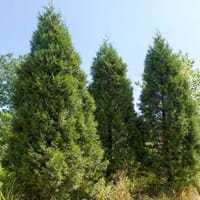Life Span
Perennial
Perennial
Type
Bulb or Corm or Tuber
Needled or Scaled Evergreen
Origin
South America
China, Japan
Types
Pamianthe cardenasii , Pamianthe parviflora , Pamianthe peruviana
Aurea,Kaizuka,Plumosa Aurea
Number of Varieties
Not Available
Habitat
All sorts of environments
Deciduous forests, Rocky areas, rocky outcrops
USDA Hardiness Zone
8-10
3-9
Sunset Zone
21,22
1a, 1b, 2a, 2b, 3a, 3b, 4, 5, 6, 7, 8, 9, 10, 11, 12, 13, 14, 15, 16, 17, 18, 19, 20, 21, 22, 23, 24
Habit
Clump-Forming
Upright/Erect
Flower Color
White
Light Yellow Green
Flower Color Modifier
Bicolor
Bicolor
Fruit Color
Green
Blue Black, Purple Brown
Leaf Color in Spring
Dark Green
Green, Blue Green, Gray Green
Leaf Color in Summer
Light Green
Green, Blue Green, Gray Green
Leaf Color in Fall
Several shades of Green
Green, Blue Green, Gray Green
Leaf Color in Winter
Light Green
Green, Blue Green, Gray Green
Leaf Shape
Strap shaped
Scale-like imbricate
Plant Season
Spring, Summer, Fall
Spring, Summer, Fall, Winter
Sunlight
Partial Sun, Partial shade
Full Sun
Type of Soil
Loam, Sand
Loam, Sand
The pH of Soil
Acidic, Neutral, Alkaline
Acidic, Neutral, Alkaline
Soil Drainage
Average
Well drained
Bloom Time
Spring, Late Spring, Early Summer, Summer, Late Summer
Early Spring, Mid Spring, Spring
Tolerances
Drought
Drought
Where to Plant?
Ground, Pot
Container, Ground, Pot
How to Plant?
Offsets
Cuttings, Seedlings
Plant Maintenance
Medium
Medium
Watering Requirements
Keep the ground moist but not water-logged
Does not require water in summer, Keep the Soil well drained, Medium
In Summer
Lots of watering
Lots of watering
In Spring
Moderate
Moderate
In Winter
Average Water
Average Water
Soil pH
Acidic, Neutral, Alkaline
Acidic, Neutral, Alkaline
Soil Type
Loam, Sand
Loam, Sand
Soil Drainage Capacity
Average
Well drained
Sun Exposure
Partial Sun, Partial shade
Full Sun
Pruning
Pinch or prune as they grow to promote branching and bushiness, Remove damaged leaves, Remove dead branches, Remove dead leaves, Requires little pruning
Remove damaged leaves, Remove dead branches, Remove dead leaves
Fertilizers
All-Purpose Liquid Fertilizer, High phosphorus
All-Purpose Liquid Fertilizer
Pests and Diseases
Leaf spot, Mosaic viruses
Scale, Spider mites
Plant Tolerance
Drought
Drought
Flowers
Showy
Not Available
Flower Petal Number
Single
Single
Foliage Texture
Coarse
Medium
Foliage Sheen
Glossy
Matte
Attracts
Bees, Birds, Bumblebees, Butterflies, Hummingbirds, pollinators
Not Applicable
Allergy
Unknown
Not Available
Aesthetic Uses
Beautification, Bouquets, Ornamental use, Showy Purposes
Bonsai, Hanging Basket, Showy Purposes, Used for decorating walls, fences, gates, hedges, etc.
Beauty Benefits
No Beauty Benefits
Not Available
Environmental Uses
Air purification
Air purification
Medicinal Uses
No Medicinal Use
Antirheumatic, Hemostatic, Hepatic, Skin Diseases, Skin wounds, treating tumours
Part of Plant Used
Not Available
Flowers, Leaves, Root, Stem
Other Uses
Beneficial species for attracting pollinators, Decoration Purposes
Decoration Purposes, Pesticide, Used as Ornamental plant
Used As Indoor Plant
No
No
Used As Outdoor Plant
Yes
Yes
Garden Design
Bog Garden, Container, Feature Plant, Foundation, Mixed Border, Water Gardens
Container, Edging, Feature Plant, Foundation, Groundcover, Hedges, Mixed Border, Topiary, Bonsai, Espalier
Botanical Name
HYMENOCALLIS longipetala
JUNIPERUS chinensis
Common Name
Peruvian Daffodil, Spiderlily
Chinese Juniper
In Hindi
peruvian daffodil
चीनी जुनिपर
In German
peruvian daffodil
chinesische Wacholder
In French
peruvian daffodil
genévrier de Chine
In Spanish
Pamianthe
enebro chino
In Greek
peruvian daffodil
Κινέζικα αρκεύθου
In Portuguese
peruvian daffodil
zimbro chinês
In Polish
peruvian daffodil
jałowiec chiński
In Latin
peruvian daffodil
Chinese iuniperorum
Phylum
Magnoliophyta
Pinophyta
Class
Liliopsida
Pinopsida
Order
Asparagales
Pinales
Family
Amaryllidaceae
Cupressaceae
Genus
Pamianthe
Juniperus
Clade
Angiosperms, Monocots
Not Available
Tribe
Clinantheae
Not Available
Subfamily
Amaryllidoideae
Cupressoideae
Number of Species
Not Available
Importance of Peruvian Daffodil and Chinese Juniper
Want to have the most appropriate plant for your garden? You might want to know the importance of Peruvian Daffodil and Chinese Juniper. Basically, these two plants vary in many aspects. Compare Peruvian Daffodil and Chinese Juniper as they differ in many characteristics such as their life, care, benefits, facts, etc. Every gardener must at least have the slightest clue about the plants he wants to plant in his garden. Compare their benefits, which differ in many ways like facts and uses. The medicinal use of Peruvian Daffodil is No Medicinal Use whereas of Chinese Juniper is Antirheumatic, Hemostatic, Hepatic, Skin Diseases, Skin wounds and treating tumours. Peruvian Daffodil has beauty benefits as follows: No Beauty Benefits while Chinese Juniper has beauty benefits as follows: No Beauty Benefits.
Compare Facts of Peruvian Daffodil vs Chinese Juniper
How to choose the best garden plant for your garden depending upon its facts? Here garden plant comparison will help you to solve this query. Compare the facts of Peruvian Daffodil vs Chinese Juniper and know which one to choose. As garden plants have benefits and other uses, allergy is also a major drawback of plants for some people. Allergic reactions of Peruvian Daffodil are Unknown whereas of Chinese Juniper have Not Available respectively. Having a fruit bearing plant in your garden can be a plus point of your garden. Peruvian Daffodil has no showy fruits and Chinese Juniper has showy fruits. Also Peruvian Daffodil is not flowering and Chinese Juniper is not flowering . You can compare Peruvian Daffodil and Chinese Juniper facts and facts of other plants too.





